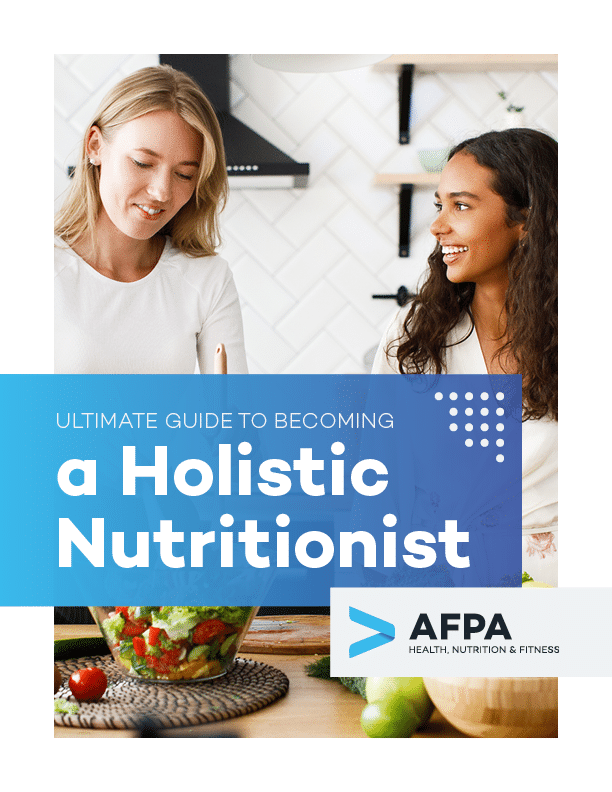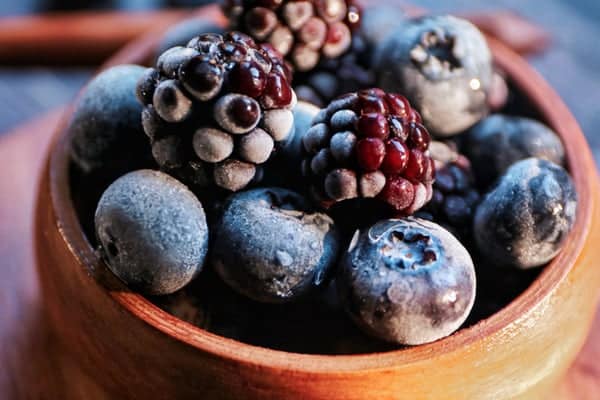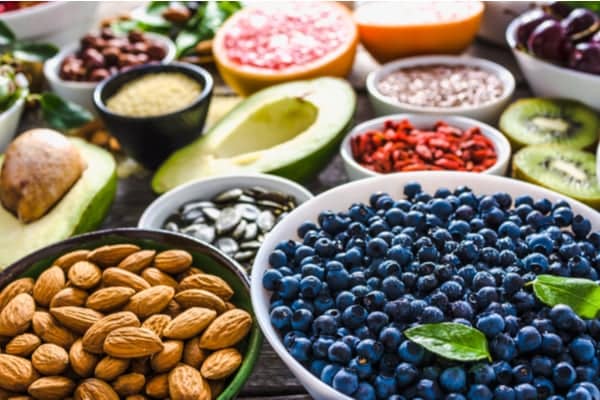When fall rolls around, the color orange suddenly seems to be dominating our spaces. From the parks with orange and yellow-colored trees to our porches and homes decorated with orange pumpkins and fall decor to even our refrigerators, orange-colored produce is a favorite for fall recipes.
Many people would agree that orange-colored produce is nice to look at; it adds brightness and flair to almost any dish. In addition, most people would be happy to know orange fruits and vegetables are packed with numerous nutrients that support a healthy immune system, help prevent disease, support a functioning metabolism, and even may help to slow cellular aging.
In this article, we explain what makes fruits and vegetables orange and how that component is the basis for many of the health-supporting properties of orange produce. We also list some of the nutrients commonly found in orange-colored produce and describe how they support your body‘s optimum health. Finally, we suggest several orange fruits and vegetables you can add to your diet seasonally.
Carotenoids: The Powerful Components That Make Fruits and Vegetables Orange
The pigments responsible for making many fruits and vegetables red, yellow, and orange are also responsible for many of the health-supporting properties.
Carotenoids are a group of phytonutrients, or chemicals made by plants. The most common carotenoids in Western diets are:
- α-carotene
- β-carotene
- β-cryptoxanthin
- lutein
- zeaxanthin
- lycopene
Some carotenoids are provitamin A carotenoids, meaning they are precursors of vitamin A (retinol) in the body. Vitamin A is essential for human growth and development early in life, normal immune system function, and vision development and maintenance.
Lutein and zeaxanthin are carotenoids that are not precursors to vitamin A, but they are selectively taken into the macula of the eye and help to support normal visual function.
Lycopene is a carotenoid that has one of the most efficient antioxidant activities of all carotenoids, allowing it to neutralize free radicals and prevent cellular damage.

Get Your Free Guide to Becoming a Holistic Nutritionist
Learn about the important role of holistic nutritionists, what it takes to be successful as one, and how to build a lucrative, impactful career in nutrition.
5 Ways Carotenoids Support Health and Prevent Disease
Potent Antioxidant Activity
In plants, carotenoids have powerful free-radical neutralizing activity. While the antioxidant activity of carotenoids is less clear, initial evidence suggests that carotenoid consumption may trigger similar antioxidant activity in humans through a chain reaction that helps to promote the upregulation of enzymes, the mediation of processes in the human body that have antioxidant and detoxifying activities.
While more studies are required to understand the mechanism of action of different carotenoids, current evidence suggests that the involvement of carotenoids in increasing antioxidant activity may help explain the anti-inflammatory and anticancer power of orange fruits and vegetables.
Supports Visual Health and May Prevent and Treat Age-Related Macular Degeneration
Carotenoids have a similar chemical structure that allows them to absorb light in a spectrum that is visible to the human eye. The carotenoids lutein, zeaxanthin, and meso-zeaxanthin efficiently absorb blue light. Blue light is of short wavelength, and when blue light reaches critical visual structures of the eye freely, it may cause light-induced oxidative damage.
Carotenoids in the macula of the eye (the center of the retina) can reduce up to 90% of the blue light that reaches the macula. The power of lutein and zeaxanthin in protecting visual integrity is so important that researchers have found supplementation with these carotenoids, in addition to the lutein and zeaxanthin obtained through the consumption of orange, yellow, and red vegetables, can help to improve contrast sensitivity and protect against visual fatigue.
With regards to age-related macular degeneration, one of the most common reasons for visual impairment and blindness with age, it has been suggested that higher levels of lutein and zeaxanthin in the diet were associated with a lower incidence of the disease.
Supports Healthy Immune Function
Vitamin A is essential for immune function. Consuming foods with carotenoids, some of which are precursors to vitamin A, can help to improve immune system health. Some clinical trials have demonstrated that supplementation with β-carotene can improve immune system biomarkers, including blood monocytes and natural killer cell activity.
May Reduce the Risk of Prostate Cancer
Prostate cancer is the most common type of cancer that affects men in the US. Studies have consistently demonstrated that diets rich in lycopene, a type of carotenoid, were associated with reductions in the risk of prostate cancer. In fact, a meta-analysis found that men with the highest intakes of raw and cooked tomatoes (notoriously high in lycopene) or dietary lycopene overall had between an 11 to 26% lower risk of developing prostate cancer in comparison to those who consumed the least lycopene.
Initial results suggest that supplemental lycopene may be beneficial in preventing and treating prostate cancer, but more research is needed.
May Reduce the Risk of Lung Cancer
Several studies have examined associations between blood concentrations of carotenoids or dietary intake of carotenoid-containing foods and lung cancer incidence. A meta-analysis of some of the largest cohort studies projected a clear picture of the relationship between carotenoid intake and lung cancer risk.
Those with the highest dietary intake of carotenoids had a 21% lower risk of developing lung cancer than those with the lowest intake. This is likely due to the intakes of cryptoxanthin and lycopene intakes, rather than β-carotene, α-carotene, lutein, and zeaxanthin, for which no associations were found.
Studies that examine whether supplemental B-carotene would have a similar effect had mixed results.
Fruits and Vegetables Highest in Carotenoids in the US Diet
The Linus Pauling Institute of Oregon State University compiled a list of fruits and vegetables based on the concentration of different carotenoids. Here, we have summarized the list, including the fruits and vegetables highest in the different types of carotenoids in the US diet.
Foods Highest in α-Carotene
- Canned pumpkin
- Carrot juice
- Cooked carrots
- Raw carrots
- Mixed vegetables (frozen and cooked)
- Winter squash
- Plantains
- Collard greens
- Tomatoes
- Tangerines
- Peas
Foods Highest in β-Carotene
- Carrot juice
- Canned pumpkin
- Sweet potato
- Cooked carrots
- Collards
- Kale
- Turnip greens
- Pumpkin pie
- Winter squash
- Raw carrots
- Dandelion greens
- Cantaloup
Foods Highest in β-Cryptoxanthin
- Pumpkin
- Papayas
- Sweet red peppers
- Orange juice
- Tangerines
- Cooked carrots
- Yellow corn
- Watermelon
- Paprika
- Oranges
- Nectarines
Foods Highest in Lycopene
- Tomato paste
- Tomato puree
- Tomato soup
- Vegetable juice cocktail
- Tomato juice
- Watermelon
- Tomatoes
- Ketchup
- Pink grapefruit
- Baked beans
Foods Highest in Lutein + Zeaxanthin
- Spinach
- Kale
- Turnip greens
- Collards
- Dandelion greens
- Mustard greens
- Summer squash
- Peas
- Winter squash
- Pumpkin
- Brussel sprouts
- Broccoli
- Sweet yellow corn
- Avocado
- Egg yolk
Main Takeaways
Eating orange, red, and yellow fruits and vegetables together with a variety of other fruits and vegetables can help to support your health. As the Linus Pauling Institute of Oregon State University states, “Recommendations by the National Cancer Institute, American Cancer Society, and American Heart Association to consume a variety of fruit and vegetables daily are aimed, in part, at increasing intakes of carotenoids.”
If your coaching client is at risk of vitamin A deficiency or conditions related to the eye or lung or prostate cancer, you may want to ask permission to share information about how orange, red, and yellow fruits and vegetables can support their health. Overall, however, it is important that your clients eat a wide variety of foods and an array of fruits and vegetables of all colors to support optimum health.

Get Your Free Guide to Becoming a Holistic Nutritionist
Learn about the important role of holistic nutritionists, what it takes to be successful as one, and how to build a lucrative, impactful career in nutrition.
References
- https://lpi.oregonstate.edu/mic/dietary-factors/phytochemicals/carotenoids
- https://pubmed.ncbi.nlm.nih.gov/2802626/
- https://pubmed.ncbi.nlm.nih.gov/25134454/
- https://pubmed.ncbi.nlm.nih.gov/18296924/
- https://pubmed.ncbi.nlm.nih.gov/19586568/
- https://pubmed.ncbi.nlm.nih.gov/27155396/
- https://pubmed.ncbi.nlm.nih.gov/9042816/
- https://pubmed.ncbi.nlm.nih.gov/8438775/
- https://pubmed.ncbi.nlm.nih.gov/8127329/
- https://pubmed.ncbi.nlm.nih.gov/18689373/
- https://pubmed.ncbi.nlm.nih.gov/15006906/
- https://pubmed.ncbi.nlm.nih.gov/12930422/
- https://pubmed.ncbi.nlm.nih.gov/12466170/
- https://pubmed.ncbi.nlm.nih.gov/15197064/



